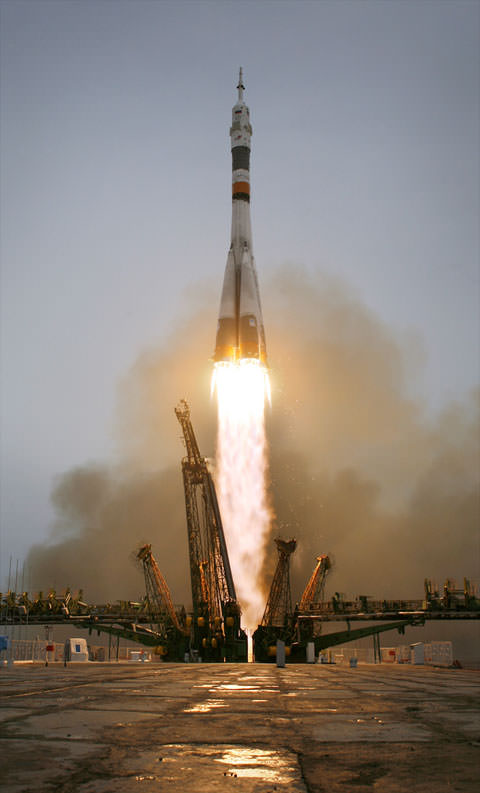[/caption]
It’s a busy day in space, with 13 humans now in orbit. A Soyuz rocket blasted off amid clouds and drizzle at the Baikonur Cosmodrome today (Thursday) sending Russian cosmonaut Gennady Padalka , American astronaut Michael Barratt,and American spaceflight participant Charles Simonyi on their way to the International Space Station. With lift-off at 11:49 a.m. GMT, Simonyi made history by becoming the first private explorer to make a second trip to the ISS. He previously flew to there in April 2007. With the shuttle Discovery crew of seven just leaving the station on Wednesday, the current ISS crew of three on board the station, and the Soyuz three, that totals equals the current record of 13 humans in space at one time*.
And things will just get busier: this new ISS crew will grow to six in May.
The Soyuz is scheduled to dock with the station at 01:14 p.m. GMT aturday, March 28. Padalka will serve as commander of Expeditions 19 and 20 aboard the station. Barratt will serve as a flight engineer for those two missions. Padalka and Barratt’s other crewmate is Koichi Wakata of the Japan Aerospace Exploration Agency. He arrived to the station March 17 on space shuttle Discovery.
Simonyi, flying to the station under a commercial agreement with the Russian Federal Space Agency, will spend 10 days aboard the ISS, and return to Earth April 7 with Expedition 18 Commander Michael Fincke and Flight Engineer Yury Lonchakov, who have been on the station since October 2008.
The Expedition 19 crew will continue science investigations and prepare for the arrival of the rest of the station’s first six-person contingent. Roman Romanenko of the Russian Federal Space Agency, Frank De Winne of the European Space Agency and Canadian Space Agency astronaut Bob Thirsk will launch from Baikonur on May 27, arriving at the station on May 29. After all the astronauts are aboard, Expedition 20 will begin, ushering in an era of six-person station crews. This mission also will be the first time the crew members represent all five International Space Station partners.
*A quick search of the times there were 13 people in space previously yielded it occurred in 1995 when STS-67 was in orbit, along with the crew of three on the Mir space station and a Soyuz in flight, and also in 1997 when STS-82 was doing a Hubble repair mission, and the Mir crew and a Soyuz crew were also in space. I’ll update that if I find out more, and if anyone else has more information, post a comment. Thanks!


Good to see two Americans using good old reliable Russian technology.
Also, odd question. Why didn’t these new astronauts travel on the last Shuttle mission. Surely adding a few more seats would have save one less mission into space?
Great to see live suitup & liftoff of Soyuz on NASA TV. Best of luck to all in orbit now and best wishes tom all involved.
I’m pretty sure the seating configuration on the orbiter is not like a mini-van. You can’t just re-arrange the seats to make room for a few more.
Besides, the seating inside the Soyuz is custom molded to the butts of the cosmo-astronauts who ride in them. If you dont send up a new Soyuz with the right seats, then the cosmonauts have to take new seating on the shuttle, replace them with the old ones, drag them back down…. a big pain probably.
A quick google shows that there were 12 people in orbit at the same time in December 1990.
oops, sorry, for some reason I kept looking at your number 13 and reading 11… getting old is Fun!
One a different topic. As a simple soul I get confused with all the different time zones in the UK and US.
Astronomers created Universal Time to overcome this problem is it too much to ask if all the Space Agencies could use it too!
This weekend in the UK we change from GMT to BST.
Brian Sheen
All space agencies use GMT, for obvious reasons. The confusion comes in when someone somewhere attempts to convert GMT to their own local time. Try looking online for simple software to convert from GMT to your local time. I believe NASA has a page with a conversion calculator.
Those old Russian rockets are still oddly aesthetically pleasing.
They just look good.
I think the cops would give you a ticket if they caught you trying to squeeze 9 people into a 7 seater shuttle!
@ Brian Sheen, here’s a link to a GMT – local time page: http://wwp.greenwichmeantime.com/ . Hope this may help you.